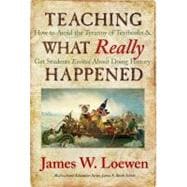
| Series Foreword | p. ix |
| Acknowledgments | p. xv |
| Introduction: History as Weapon | p. 1 |
| A Lesson from Mississippi | p. 2 |
| A Lesson from Vermont | p. 7 |
| Why History Is Important to Students | p. 10 |
| Why History Is Important to Society | p. 15 |
| The Tyranny of Coverage | p. 19 |
| Forests, Trees, and Twigs | p. 19 |
| Winnowing Trees | p. 21 |
| Deep Thinking | p. 23 |
| Relevance to the Present | p. 25 |
| Skills | p. 28 |
| Getting the Principal on Board | p. 30 |
| Coping with Reasons to Teach "As Usual" | p. 32 |
| You Are Not Alone | p. 36 |
| Bringing Students Along | p. 38 |
| Expecting Excellence | p. 42 |
| Racial and Socioeconomic Characteristics Affect Teacher Expectations | p. 42 |
| Research on Teacher Expectations | p. 47 |
| "Standardized" Tests Affect Teacher Expectations | p. 49 |
| Statistical Processes Cause Cultural Bias in "Standardized" Tests | p. 51 |
| Social Class Affects "Standardized" Test Scores | p. 54 |
| Internalizing Expectations | p. 56 |
| Teachers and "Standardized" Tests | p. 58 |
| Teachers Can Create Their Own Expectations | p. 60 |
| Historiography | p. 68 |
| A Tale of Two Eras | p. 68 |
| The Civil Rights Movement, Cognitive Dissonance, and Historiography | p. 71 |
| Studying Bad History | p. 76 |
| Other Ways to Teach Historiography | p. 80 |
| Doing History | p. 83 |
| Doing History to Critique History | p. 83 |
| Writing a Paper | p. 87 |
| How and When Did People Get Here? | p. 103 |
| A Crash Course on Archeological Issues | p. 105 |
| Presentism | p. 109 |
| Today's Religions and Yesterday's History | p. 110 |
| Conclusions About Presentism | p. 112 |
| Chronological Ethnocentrism | p. 113 |
| Primitive to Civilized | p. 114 |
| Costs of Chronological Ethnocentrism | p. 116 |
| Why Did Europe Win? | p. 123 |
| The Important Questions | p. 123 |
| Looking Around the World | p. 124 |
| Explaining Civilization | p. 127 |
| Making the Earth Round | p. 128 |
| Why Did Columbus Win? | p. 131 |
| The Columbian Exchange | p. 133 |
| Ideological Results of Europe's Victory | p. 136 |
| Cultural Diffusion and Syncretism Continue | p. 137 |
| The $24 Myth | p. 141 |
| Deconstructing the $24 Myth | p. 141 |
| A More Accurate Story | p. 145 |
| Functions of the Fable | p. 147 |
| Overt Racism? | p. 150 |
| Additional Considerations | p. 153 |
| Teaching Slavery | p. 155 |
| Relevance to the Present | p. 155 |
| Hold a Meta-Conversation | p. 159 |
| Slavery and Racism | p. 162 |
| Four Key Problems of Slave Life | p. 165 |
| Additional Problems in Teaching the History of Slavery | p. 170 |
| Why Did the South Secede? | p. 175 |
| Teachers Votes | p. 175 |
| Teaching Against the Myth | p. 179 |
| Examining Textbooks | p. 183 |
| Genesis of the Problem | p. 186 |
| The Nadir | p. 189 |
| Contemporary Relevance | p. 189 |
| Onset of the Nadir | p. 192 |
| Historical Background | p. 194 |
| Underlying Causes of the Nadir of Race Relations | p. 195 |
| Students Can Reveal the Nadir Themselves | p. 197 |
| During the Nadir, Whites Became White | p. 200 |
| End of the Nadir | p. 204 |
| Implications for Today | p. 206 |
| Afterword: Still More Ways to Teach History | p. 209 |
| Notes | p. 213 |
| Index | p. 237 |
| About the Author | p. 248 |
| Table of Contents provided by Ingram. All Rights Reserved. |
The New copy of this book will include any supplemental materials advertised. Please check the title of the book to determine if it should include any access cards, study guides, lab manuals, CDs, etc.
The Used, Rental and eBook copies of this book are not guaranteed to include any supplemental materials. Typically, only the book itself is included. This is true even if the title states it includes any access cards, study guides, lab manuals, CDs, etc.